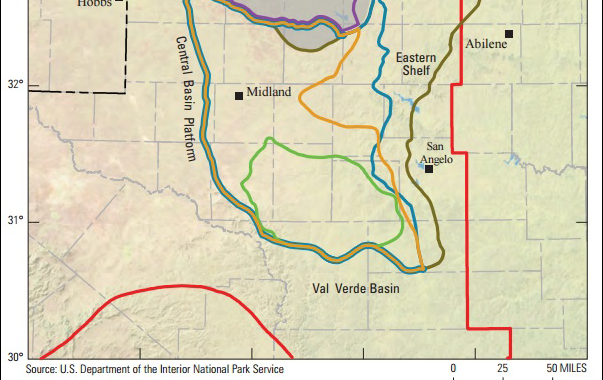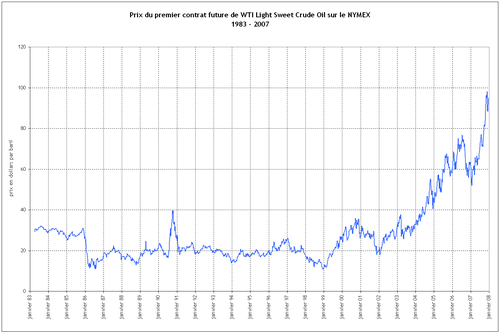
Largest Ever U.S. Shale Oil Deposit Identified in Texas
The Wolfcamp shale, which underlies a large swath of Texas roughly centered on the city of Midland, contains 20 billion barrels of oil that could be recovered with current technology.
A water pool attached to Robinson Drilling rig 4 in Midland County, Texas. Last week, the USGS estimated that the Wolfcamp shale that lies beneath the Midland region is the largest shale oil deposit ever identified in the United States. Credit: Associated Press/James Durbin, Reporter-Telegram
As global oil prices remain mired in their worst downturn in decades, news from western Texas suggests that petroleum fortunes continue to smile on the region.
In its first assessment in nearly a decade of the Permian Basin, a large sedimentary basin underlying parts of Texas and New Mexico, the U.S. Geological Survey (USGS) has determined that a vast deposit of shale there, known as the Wolfcamp shale, contains much more oil than previously estimated. In fact, according to a USGS announcement last Tuesday, the region contains what is estimated to be the largest amount of continuous oil—meaning oil accessible only by means of hydraulic fracturing, or fracking—ever assessed in the United States. The agency estimated the Wolfcamp shale contains 20 billion barrels (3.2 billion cubic meters) of oil that can be recovered using today’s technology. That’s nearly 3 times as much recoverable oil as estimated in the Bakken–Three Forks accumulation in North Dakota. A similar assessment had estimated, in 2013, that the Bakken–Three Forks oil field was the largest continuous oil accumulation in the United States.
Unlike “conventional” oil that accumulated underground in discrete, buoyant pools on a column of water and can be drawn to the surface using a traditional vertical drilling rig, unconventional continuous oil accumulations commonly occur in shale reservoirs or coal beds. In these accumulations, the oil has dispersed throughout the geologic formation.
The Wolfcamp shale lies in the Midland Basin portion of the Permian Basin. The map shows the basin’s “assessment units” (regions with similar geology, exploration strategy, and risk characteristics) in west Texas. Credit: U.S. Geological Survey, Energy Resources Program
The Wolfcamp shale makes up part of the Midland Basin, a major component of the Permian Basin, along with the Delaware Basin and the Central Basin Platform. The Permian’s basins were low-lying marine features that collected sediments rich in organic, deepwater material, which eventually became the petroleum source rocks in production today. According to Chris Schenk, project chief of the National and Global Petroleum Assessment and a coauthor of the USGS report, the Permian source rocks form strong stratigraphic traps that seal oil in the rocks, creating one of the best petroleum systems in the world.
The Wolfcamp shale also contains an estimated 16 trillion cubic feet (453 billion cubic meters) of associated natural gas and 1.6 billion barrels (245 million cubic meters) of natural gas liquids, according to USGS.
Welcome, but Not Surprising, for Petroleum Industry
The agency’s announcement hardly comes as a surprise to those who work in the Permian Basin. In a statement to Eos, the Permian Basin Petroleum Association commented that the USGS estimate was exciting but was more of a confirmation than a new story.
The Wolfcamp shale also contains an estimated 16 trillion cubic feet of associated natural gas and 1.6 billion barrels of natural gas liquids, according to USGS.
Troy Cook, a petroleum engineer with the U.S. Energy Information Administration, agreed and added that if anything, some companies may even find the estimate on the low end. For example, the oil company Pioneer Natural Resources has stated that continuous oil in the Wolfcamp shale and an overlying deposit known as the Spraberry Formation could eventually produce upward of 100 billion barrels (16 billion cubic meters) of oil.
For decades, oil and gas companies have used vertical wells to access conventional oil accumulations in the Permian Basin; however, the oil industry is now mostly using hydraulically fractured horizontal wells to retrieve the continuous oil found in the Wolfcamp shale.
Schenk said there are roughly 3000 horizontal wells currently operating in the Wolfcamp shale. Production data from these wells, along with research articles, industry subsurface data, and other background sources, were used to craft a geologic framework of the basin and derive the newly reported estimate.
Even Greater Potential?
Cook noted that although the USGS estimate is substantial, it is hard to determine if the assessment is big or small compared to other potential resources in the Permian Basin. The Permian Basin is one of the most prolific basins in the world, he said, and as engineering and technology evolve, they may open up other shale resources for exploration and development.
The Permian Basin is one of the most prolific basins in the world, and it may contain other unknown shales with large potential resources.
Walter Guidroz, program coordinator for the USGS Energy Resources Program, said in the USGS press release, “The fact that this is the largest assessment of continuous oil we have ever done just goes to show that, even in areas that have produced billions of barrels of oil, there is still the potential to find billions more.”
The USGS assessment, although large, may not capture the full extent of the Wolfcamp resource. Because well production data inform so much of the estimate, the estimated resource could grow even larger in time as new wells provide more data, Schenk said.


